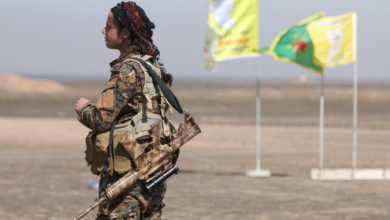
In Syria, the alliance of minorities is counterproductive
Sultan Al-Atrash, a leading figure in the Great Syrian Revolt against the French in 1925, remains a larger-than-life hero in Druze folk culture. These days, the Druze of Syria find themselves at a crossroads and need to decide where their loyalties lie, as the country faces the threat of disintegration as well as extremist takfirists seeking to impose their hegemony over the land. For the Druze, this a situation they have always sought to avoid.
These days, the Druze of Syria find themselves at a crossroads and need to decide where their loyalties lie.
Eyad Abu Shakra
As an esoteric Muslim minority that grew out of Ismaili Shiism, the Druze have almost always acted as a community that was keenly aware of its small size, and consequently its interests, and thus has rarely committed anything approaching a fatal mistake. Even after the Fatimid Caliph Ali Al-Zahir destroyed their confessional “call” in Egypt, and later the demise of the Shiite Ismaili presence there at the hands of the Ayyubid dynasty, the latter – who were Sunni Kurds – recognized the Druze as the military rulers of Mount Lebanon, in appreciation of their valiant defense of the Muslim Levant against the Crusaders.
Indeed, while they suffered massive persecution and massacres at the hands of Al-Zahir and his clients –the most prominent of which were the Shiite Merdassi Arab rulers of Aleppo – the Druze were never truly engaged in sectarian confrontations with their majority-Sunni neighbors. In fact the opposite was true, as the two great Mamluk and Ottoman states continued to respect the Druze control of, and privileges in, Mount Lebanon and adjacent areas. In turn, the Druze were astute in their dealings with these two dominant regional powers, always keeping their options open during times of turmoil and change.
Then, when the Safavids of Iran challenged the Ottoman Empire during the 16th century, the Druze, led by the princely Ma’an dynasty, which hails from the great Arab mother tribe of Rabi’a Bin Nizar, sided politically and militarily with the Ottomans.
When Ma’anid rule came to an end, the Druze of Mount Lebanon accepted the Sunni Shihab princely dynasty, who are related through marriage to the Druze Ma’anids. Later on, as the Jumblatti–Yazbaki factionalism dominated Mount Lebanon’s politics in the 18th century, Druze, Sunni, and Christian clans joined the two non-sectarian rival factions.
This coexistence was a feature of what became present-day Lebanon, as well as Syria and Palestine. The skirmishes and larger clashes the Druze were part of here and there were primarily examples of clashes between villagers and Bedouins. In northern Palestine, the Druze were engaged in two local confrontations, both of which were of a feudal–tribal nature and not really sectarian at all – the first in the 16th century with Sheikh Ahmad Bin Tarabay al-Harithi, the chieftain of the Hawareth tribe, and the second in the 18th century with Sheikh Dhaher al-Omar al-Zaydani of the Zayadena tribe. Such confrontations were commonplace between the settled villagers and marauding Bedouins, competing feudal clans, as well as rival sub-clans. (It is worth remembering that the pre-Islamic Arab Qaysi–Yemeni rivalry continued in Palestine well into the 20th century, unlike Lebanon, where it ended in 1711 with the Qaysi victory in ‘Ayn Dara.)
The same situation occurred in Mount Hawran in southern Syria, settled by Druze immigrants from Aleppo, Mount Lebanon, Wadi Al-Taym (southwest Lebanon), and northern Palestine. It was obvious that the increasing numbers of new settlers would lead to clashes with existing local inhabitants, most of whom were also Bedouins living in the region that divided the desert from farmland. Here, too, clashes were connected with rights to wells and pastures rather than religion and sect. During the Great Syrian Revolt of 1925, the Druze of Mount Hawran in the east and the Sunnis of the Hawran plain in the west fought side-by-side against the French. Furthermore, when modern secular party politics came onto the scene, the Baath Party attracted Druze, Sunni, and Christian alike from both the mountain and the plain.
Another aspect worth analyzing is that the notion of an alliance of minorities against the vast sea of Sunni Islam was never truly taken seriously by at least two Levantine religious minorities: the Druze from the Muslim camp, and the Orthodox Church of Antioch from the Christian camp. It is said that when the Mutasarrifate (Special District) of Mount Lebanon was created in 1861, the Orthodox refused to be part of a newly created entity with a Maronite Christian majority, preferring, rather, to remain part of the Ottoman Province of Syria (Damascus). One of the Orthodox leaders of the time remarked it was “better [to] stick with the Turks than join the Maronites.”
Add to the above the fact that the internecine conflicts among the minorities themselves have always been quite acute and had nothing to do with any overarching strategic alliance, which runs contrary to what some powers like Iran are now promoting as a bulwark against takfirist and jihadist groups like ISIS and its ilk.
Internecine conflicts among the minorities themselves have always been quite acute and had nothing to do with any overarching strategic alliance.
Eyad Abu Shakra
Antiochian Orthodox Christians, for example, were allies of the Druze in their sectarian battles against the Christian Maronites in the mid-19th century, while the Alawi–Ismaili animosity in northwest Syria was so severe it resulted in the uprooting of whole communities; likewise, Shiite–Druze relations were far from cordial under the pro-Ottoman Ma’anids of Mount Lebanon, while the Shiites sided with the Safavids of Iran.
Based on such a history, the call made by wise Druze leaders to their community, urging them to distance themselves from a bloodthirsty regime that has ruined Syria and brought suffering to all its communities, is based on several considerations.
Neither the Druze, nor other minorities, have a vested interest in forming an alliance that can only serve the purpose of extremists among the Sunni Muslim population of Syria.
Eyad Abu Shakra
First, a rejection of violence, dictatorship and corruption and a desire to preserve the country from fragmentation and bloody intrigues, as well as exposing those who are willing to base their rule on murder and subjugation.
Second, a patriotic vision of a Syria that is a nation for all its citizens – instead of pushing its constituent religious, sectarian, racial and linguistic communities into the abyss of endless civil war. While some may say it is a struggle against extremists, in truth this would just be an attempt, via moves to exploit extremism, to incite counter-extremism in order to justify preserving the status quo.
Finally, considerations of geopolitical interests. The Druze are geographically scattered in disjointed areas, except in Sweida Province. However, even in this province they have no interest in being enemies of their kin and neighbors on the Hawran plain to the west. Their area, bordered on the east and south by desert, is simply not viable as a separate entity.
Thus neither the Druze, nor other minorities, have a vested interest in forming an alliance that can only serve the purpose of extremists among the Sunni Muslim population of Syria. Instead, it is their duty to reassure the Sunnis, especially during these dangerous times, that Syria’s minorities stand against any regional or international conspiracy that targets them; that they have absolutely no interest in being “human shields,” in protecting a gang hell-bent on implicating them in its crimes, and hiding behind them rather than protecting and defending them.
This article was first published in Asharq al-Awsat newspaper on Thursday, Nov. 13, 2014.
alarabiya.ne



